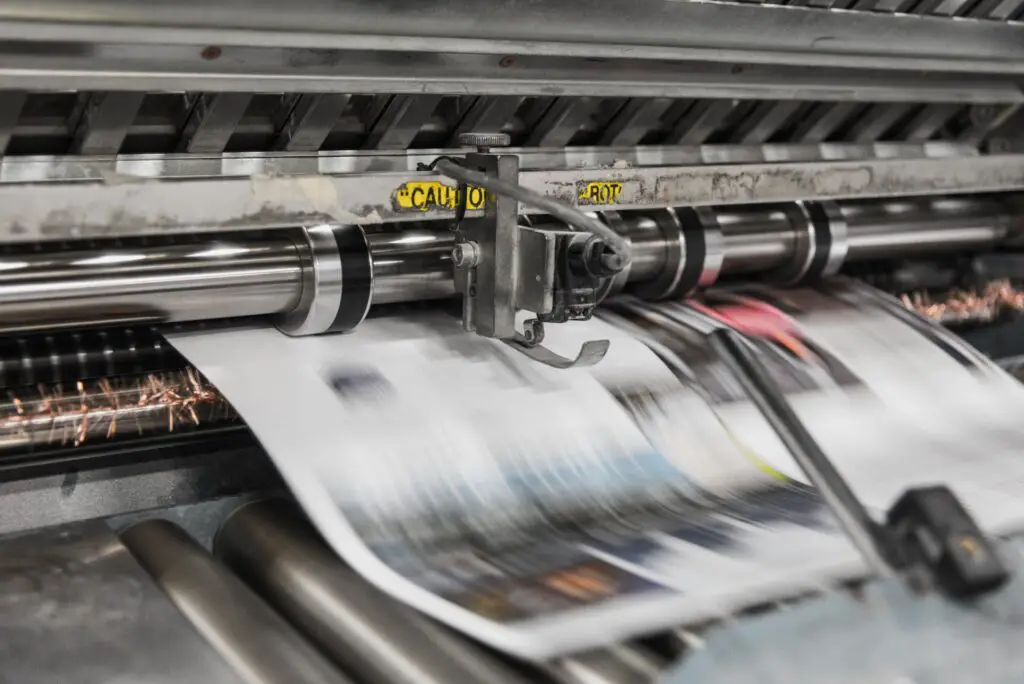In today’s hypercompetitive business landscape, it has become increasingly crucial for companies to stay ahead of the curve and meet the ever-evolving demands of customers. This is especially true in the print market, where understanding consumer preferences and leveraging personalization have become key drivers for success.

Understanding the Print Market
A deep understanding of the print market is essential for any company looking to thrive in this industry. By keeping abreast of the latest trends and knowing the key players, businesses can better position themselves to capture a larger market share.
The online printing market is a dynamic and ever-evolving industry that plays a vital role in the country’s economy. With advancements in technology and changing consumer preferences, it is crucial for businesses to stay informed about the current trends and key players driving the market forward.
Current Latest Trends in the Printing Industry
The printing industry is currently experiencing several noteworthy trends that are shaping its landscape. One of the most significant trends is the shift towards digital printing. With its increased speed and cost efficiency, digital printing has revolutionized the industry, allowing businesses to produce high-quality prints at a fraction of the time and cost compared to traditional printing methods.
Moreover, there has been a growing demand for eco-friendly print solutions. As consumers become more conscious of their environmental impact, they are actively seeking print providers that offer sustainable and environmentally friendly options. This trend has prompted many companies to adopt greener practices, such as using recycled paper and vegetable-based inks, to meet the demands of eco-conscious consumers.
Another notable trend in printing industry is the rise of personalized printing. With advances in online printing technology, businesses can now offer customized prints tailored to individual customers’ preferences. This trend has gained popularity across various industries, including marketing, retail, and event management, as it allows businesses to create targeted and highly personalized print materials that resonate with their target audience.
The Rising Demand for Personalization
One of the most impactful trends in the printing industry is the rising demand for personalization. Customers now expect tailored products and experiences that align with their individual preferences and needs.
Personalization has become a driving force in the print industry, revolutionizing the way businesses interact with their customers. It goes beyond simply adding a name to a product; it encompasses a range of customization options that allow individuals to express their unique style and personality. From personalized stationery to custom-designed clothing, the possibilities are endless.
What is Driving the Personalization Trend?
Several factors are driving the increasing demand for personalization in the print market. One of the primary drivers is the increasing desire for unique and custom-made products. Customers are no longer satisfied with generic offerings and are willing to pay a premium for personalized items.
Advancements in technology have also played a significant role in the rise of personalization. With the advent of digital printing and sophisticated online designer tool, it has become easier than ever for businesses to offer customized products. This has opened up new opportunities for small businesses and entrepreneurs to enter the market and cater to niche audiences.
Furthermore, the rise of social media has fuelled the personalization trend. Platforms like Instagram and Pinterest have created a culture of self-expression, where individuals are constantly seeking ways to stand out from the crowd. Personalized products allow people to showcase their unique identity and share it with the world.
The Impact of Personalization on Customer Engagement
Personalization has a profound impact on customer engagement and loyalty. By offering personalized printed products, companies can create a stronger emotional connection with their customers and foster long-term relationships. This, in turn, leads to increased customer satisfaction and advocacy.
When customers receive a personalized product, they feel valued and understood by the brand. It shows that the company has taken the time to cater to their specific needs and preferences. This level of attention to detail can significantly enhance the overall customer experience and leave a lasting impression.
Moreover, personalized products have the power to evoke positive emotions and create memorable moments. Whether it’s a customized wedding invitation that captures the essence of a couple’s love story or a personalized children’s book that makes a child feel like the hero of their own adventure, these unique experiences leave a lasting impact on the recipients.
Personalization also has a ripple effect on customer loyalty. When individuals feel a strong emotional connection with a brand, they are more likely to become repeat customers and recommend the company to their friends and family. Word-of-mouth marketing becomes a powerful tool, fueled by the personalized experiences that customers have had.
In conclusion, the rising demand for personalization in printing industry is driven by the desire for unique products, advancements in technology, and the influence of social media. Personalization not only enhances the customer experience but also fosters stronger engagement and loyalty. As the print industry continues to evolve, businesses that embrace personalization will undoubtedly have a competitive edge in the market.
Implementing Personalization in Print
Implementing personalization in the print industry requires a combination of technology, creativity, and strategic thinking. Companies must stay ahead of the curve by embracing technological innovations and developing effective strategies to deliver personalized print products.
Personalization is more than just adding a customer’s name to a printed piece. It involves tailoring the content, design, and messaging to meet the unique needs and preferences of each individual, which is especially effective in niche markets like medical print marketing services. This level of customization creates a deeper connection between the brand and the customer, resulting in increased engagement, loyalty, and ultimately, sales.
One of the key technological innovations facilitating personalization in the print industry is variable data printing (VDP). VDP allows for the customization of individual elements within a printed piece, such as text, images, and graphics. This means that each print can be unique and tailored specifically to the recipient. Whether it’s a personalized direct mail campaign or a customized brochure, VDP enables companies to deliver highly targeted and relevant content to their customers.
Another technological innovation that has revolutionized personalization in print is the availability of online design tools. These tools provide designers with the flexibility and freedom to create personalized print products with ease. With just a few clicks, designers can incorporate personalized elements into their designs, such as names, images, and even personalized messages. This not only saves time and resources but also allows for greater creativity and experimentation.
Technological Innovations Facilitating Personalization
Advancements in technology have revolutionized the way personalization is implemented in the printing industry. From variable data printing to digital design tools, companies have access to a wide range of solutions that enable them to offer personalized experiences at scale.
One of the most exciting technological innovations in the print industry is the integration of augmented reality (AR) into printed materials. AR allows for interactive and immersive experiences, where customers can engage with printed products in a whole new way. For example, a personalized catalog can come to life when viewed through a smartphone or tablet, providing additional information, videos, and even the ability to make a purchase directly from the catalog.
Furthermore, advancements in data analytics and artificial intelligence (AI) have opened up new possibilities for personalization in print. By leveraging customer data and AI algorithms, companies can analyze customer preferences, behaviors, and purchase history to create highly targeted and personalized print campaigns. This level of personalization goes beyond just adding a name; it allows companies to deliver content that is truly relevant and meaningful to each individual customer.
Successful Personalization Strategies
Personalization and customization are key strategies that can greatly enhance the value and impact of print products for businesses. Leveraging Web-to-print (W2P) technology is essential for successfully implementing these approaches. Let’s explore some effective ways to incorporate personalization and customization in a print business using W2P technology:
- Engaging Online Design Tools: Provide customers with user-friendly online design tools that make it a breeze for them to personalize their print products. These tools should offer a wide array of customizable elements, like text, images, colors, and layouts. As customers make changes, they should be able to see real-time previews of their designs.
- Tailored Templates: Curate a collection of pre-designed templates that customers can use as a starting point for their personalized products. By offering templates that cater to various industries and purposes, customers can easily find a design that aligns with their unique requirements.
- Variable Data Printing (VDP): Unlock the potential of variable data printing, which enables customization within a print run. This allows for personalizing individual elements, such as names, addresses, or generating a unique QR codes, tailored to the preferences or needs of each recipient.
- Seamless Data Integration: Integrate the W2P system with customer databases or third-party APIs to access relevant customer data. This information can include names, addresses, purchase history, or other personalization details, making it effortless to incorporate personalized content into print products.
- Multichannel Personalization: Extend personalization capabilities beyond print by integrating W2P with other marketing channels, such as email, social media, or mobile apps. This fosters a consistent and cohesive personalized experience for customers across various touchpoints.
- Simplified Reordering: Make it easy for customers to reorder their personalized products by storing their order history. This feature not only saves customers time but also encourages repeat business.
- Real-time Pricing and Proofing: Offer customers real-time pricing estimates based on their customizations, empowering them to make informed decisions. Additionally, provide instant proofs for approval before finalizing the order to minimize errors and delays.
- Mobile-friendly Experience: Ensure that the W2P platform is mobile-responsive, accommodating customers who prefer designing and ordering from their smartphones or tablets. A smooth mobile experience can boost customer satisfaction and engagement.
- Stellar Customer Support: Deliver exceptional customer support to assist customers throughout the design and ordering process. Features like live chat, email support, or phone assistance can address any concerns or questions, making customers feel valued.
- Personalized Marketing: Utilize personalized marketing campaigns to showcase the benefits of customization and personalization. Success stories, testimonials, and creative ideas can inspire customers to explore personalized print products.
By incorporating W2P technology and embracing these personalized and customized print strategies, print businesses can provide customers with unique and compelling experiences, while also fostering loyalty and driving revenue growth.
Challenges and Solutions in Personalized Printing
While personalization offers numerous benefits, it also comes with its fair share of challenges. Overcoming these obstacles requires innovative thinking and a focus on continuous improvement.
Overcoming Obstacles in Personalized Printing
One common challenge in personalized printing is maintaining efficiency and cost-effectiveness while catering to individual customer preferences. Companies must find ways to strike a balance between customization and streamlined production processes.
Future Prospects for Personalized Printing
As technology continues to advance and consumer expectations evolve, the opportunities for personalized printing will only increase. Companies that embrace personalization and adapt to the changing landscape will be well-positioned for success.
Conclusion: The Power of Personalization in the Print Market
In conclusion, harnessing the power of personalization is crucial for businesses operating in the print market. By understanding the market landscape, meeting the rising demand for personalized products, and overcoming the challenges of implementation, companies can position themselves for long-term success.
Looking Forward: The Future of Personalization in Print
As the printing industry continues to evolve, personalization will undoubtedly play an even more significant role in shaping customer experiences. Companies that stay adaptive and embrace the power of personalization will have a competitive edge in meeting customer demands and driving business growth.









0 Comments